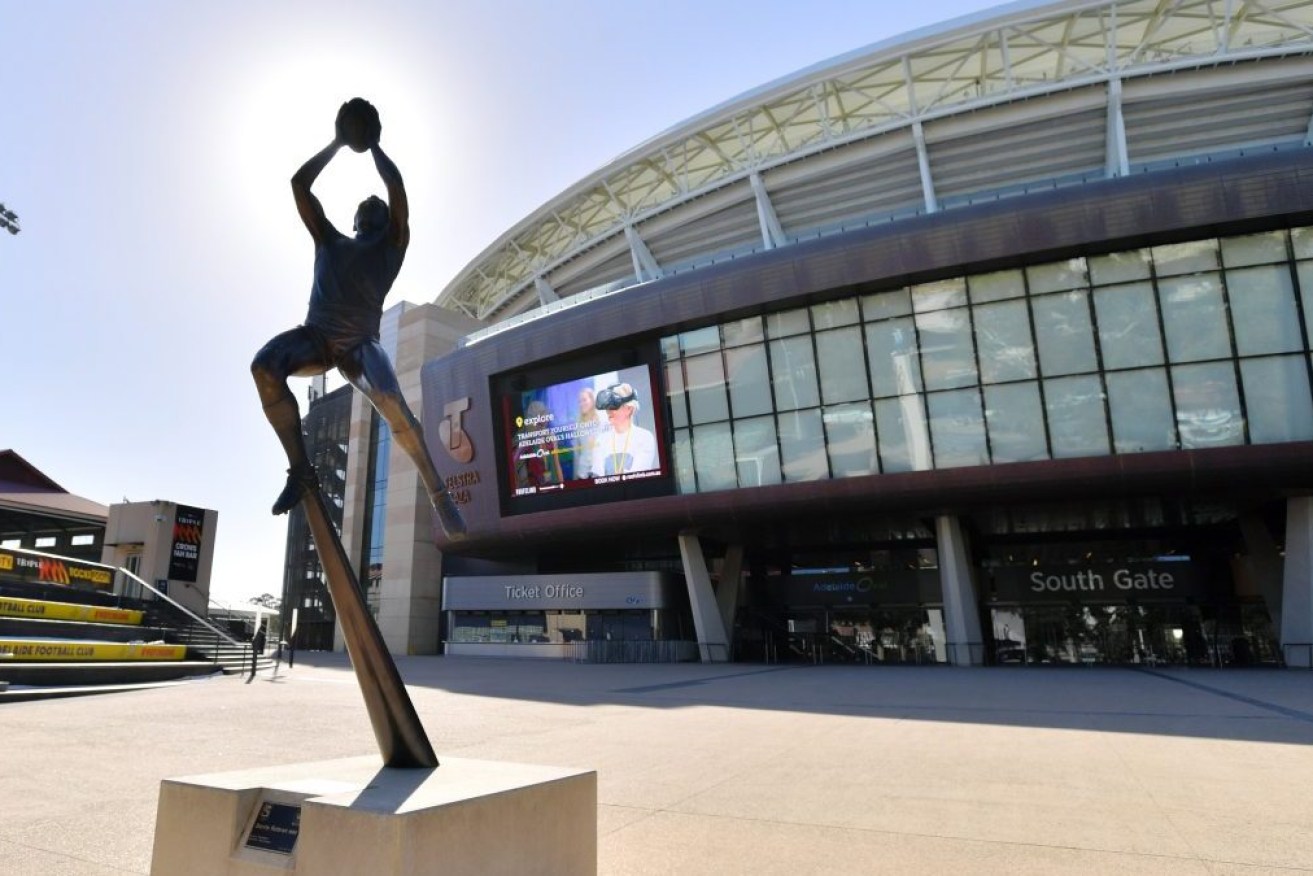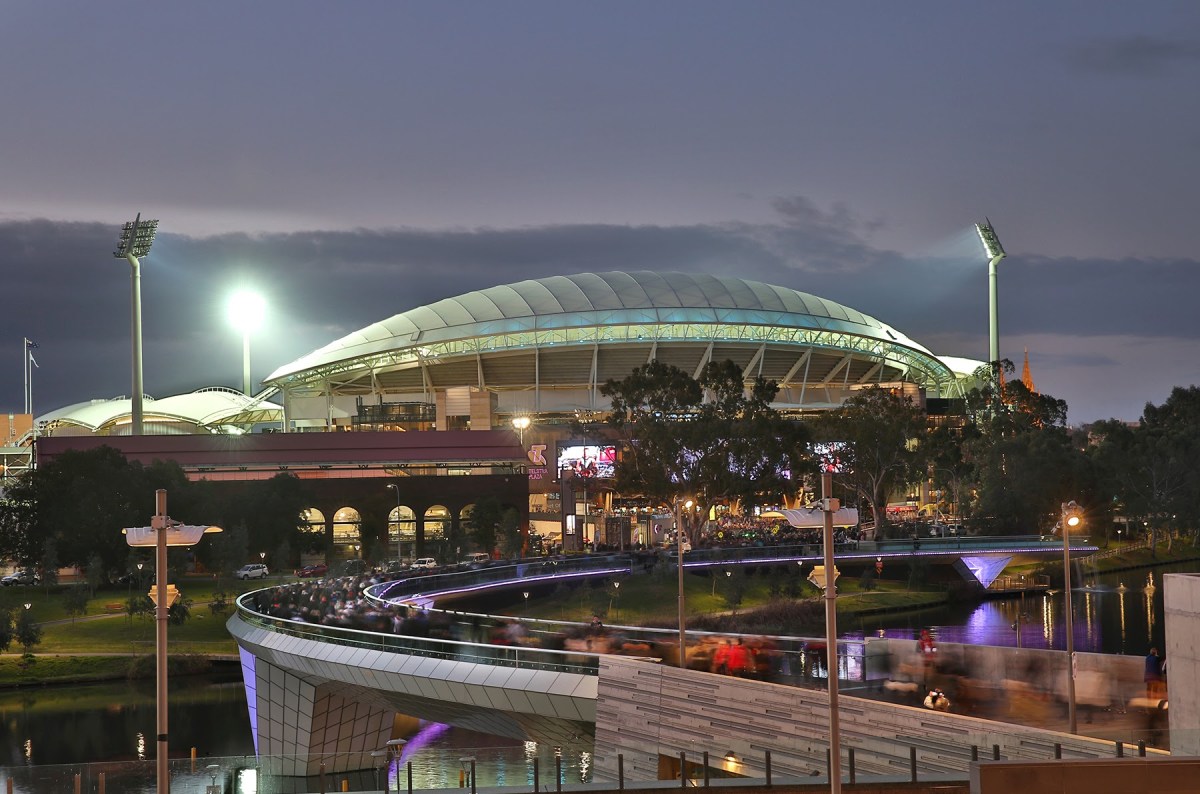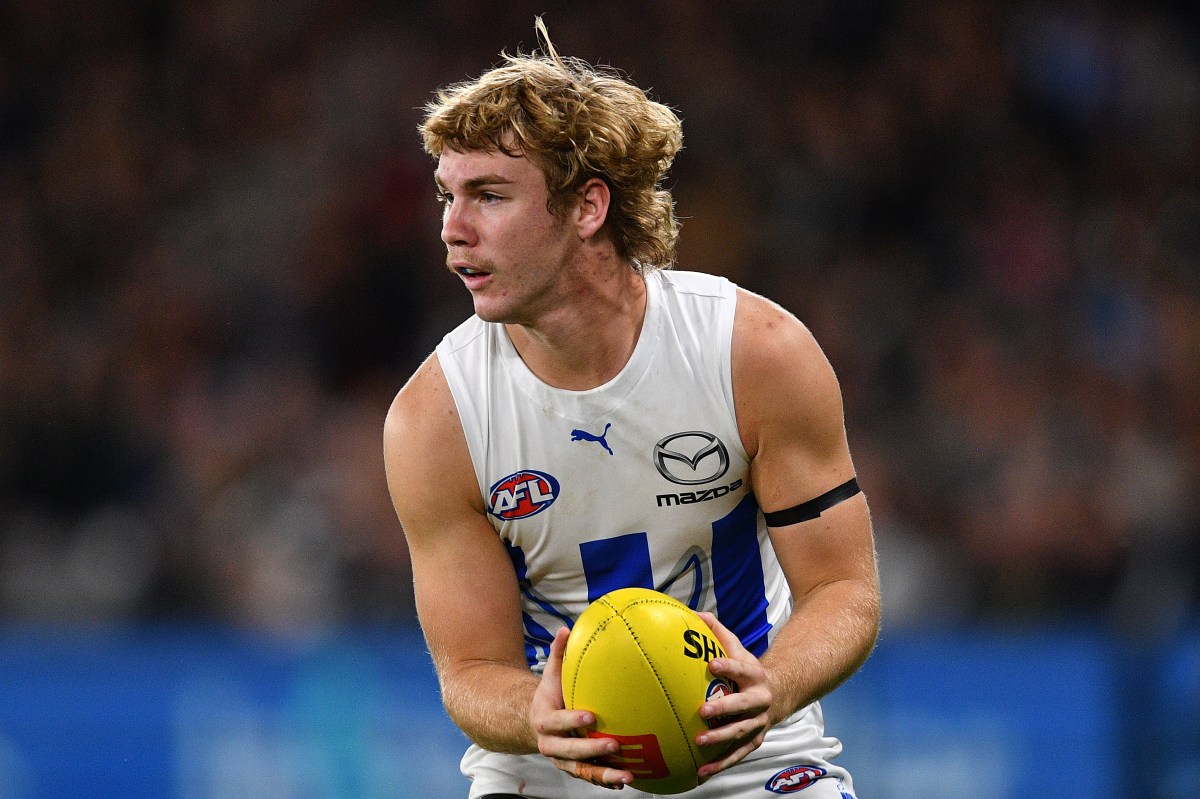The leap of faith to come home to SA football
More South Australian footballers leave through the AFL national draft than ever return to the Crows or Port Adelaide by the annual trade market. But is the hard sell to lure them home finally working? Michelangelo Rucci reports.

Adelaide Oval. Photo: AAP/Morgan Sette
Brownlow Medallist Adam Cooney cleared his locker at the Western Bulldogs at the end of his first AFL season in 2004 hoping his summer return to the family home in Adelaide would be more than a holiday.
“I told all my coaches,” says Cooney, “that I did not want to go back (to the Western Bulldogs). I was staying in Adelaide. But then you put your ‘big boy’ pants on …”
Cooney returned to The Kennel at Footscray to fulfill everything the Western Bulldogs talent scouts expected – an 11-season career, 219 games and All-Australian honours in 2008 when he became the seventh South Australian to don the Brownlow Medal as the AFL’s fairest-and-best player of the season.
And still the 2003 No. 1 draftee has never returned to Adelaide as a full-time resident, let alone an AFL player with either the Crows or Port Adelaide. He even preferred a swansong with Essendon, playing 31 matches across 2015 and 2016 when the Melbourne-based club was in need of experienced talent to fill the void created by the sanctions from the infamous supplements saga at Windy Hill.
“They’d ask,” recalls Cooney of the calls that would be made by the Adelaide Football Club recruiting team to his manager every six months. “And the answer was always the same, ‘Let’s see what happens at the end of the year’. It was very good for leveraging a new contract with the Western Bulldogs.”
Cooney is among the large assembly of Who’s Who achievers among South Australian footballers never to come home. Hall of Famer Matthew Pavlich stayed at Fremantle, regardless of the seemingly endless overtures from Adelaide. Shannon Hurn, draft pick No. 13 in 2005 from Central District, became a premiership captain at West Coast and still has not returned to the family farm in the Barossa.
Collingwood ruckman Brodie Grundy last month opted to consider offers from Geelong and Melbourne rather than make a homecoming move to Port Adelaide, where his brother Riley was once on the club’s rookie list.
Norwood draftee James Aish (No. 7 in 2013) has preferred to move from coast to coast – Brisbane, Collingwood and currently Fremantle – rather than play his AFL football at home in Adelaide. Another South Australian winner of the Brownlow Medal, Narcoorte’s Lachie Neale (No. 58 draftee in 2011 from Glenelg), also bypassed Adelaide when shifting out of Fremantle to find his new football home at Brisbane at the end of the 2018 season.
And the list of South Australians taken in the AFL national draft but who never answered the Crows or Port Adelaide’s calls during the annual trade period is much longer than those who did return to play for the two South Australian AFL clubs. Dylan Stephens (now at Sydney), Brennan Cox (Fremantle), Caleb Daniel (Western Bulldogs), Jack Redden (Brisbane and then West Coast), Shane Edwards (Richmond), Matthew Stokes (Geelong), Ryan Griffen (Western Bulldogs), Beau Waters (West Coast), Andrew Mackie (Geelong), Norm Smith Medallist Brian Lake (Hawthorn and Western Bulldogs) …
Port Adelaide football boss Chris Davies last week noted “there are too many players who leave South Australia to return to their home states”, such as Victorian Karl Amon who has taken up free agency to leave Alberton to join Hawthorn this month.
“So we need to make sure we’ve to an interest in players who want to come home to South Australia,” added Davies, whose club has in recent years claimed Jay Schulz (Richmond), Jared Polec (Brisbane), Jack Hombsch (Greater Western Sydney), Ryan Burton (Hawthorn), Scott Lycett (West Coast), Orazio Fantasia and Angus Monfries (Essendon) in “come home” trades.
For much of the past two decades, the battle to reclaim talent lost in the lottery of the AFL national draft has overwhelmed the recruiting men at the Crows and Port Adelaide. Matt Rendell, the Adelaide recruiting master from 2007 to 2012, admits the task of luring players into a “come home” trade became so frustrating that he ultimately gave up.
“I didn’t even bother in the end,” Rendell said. “It was too hard to move them, even South Australians.
“I would ring the managers every February,” recalls Rendell of the moments such as the “check in” calls with players such as Cooney. “I would ask about every South Australian, what their status was with contracts. I could not get any bites.
“The managers would say, ‘No, no. They don’t want to go back to South Australia’. I could half-understand it. I did the same thing (in leaving West Torrens in the SANFL for Fitzroy in the VFL in 1981). I really loved Melbourne. I love South Australia as well, but I really loved living in Melbourne. I could relate to what these players were saying when they would tell me they were happy.
“I used to have this saying: ‘In Melbourne, you have options’. You didn’t have a lot of options in Adelaide.”
In the middle of the recent AFL season it seemed the challenge of luring home South Australians had become tough even in the “new market” zones of Gold Coast. Jack Lukosius, the No. 2 draft pick in 2018 from Woodville-West Torrens, was heavily courted by Port Adelaide and the Crows last year. In mid-June, the former Woodville-West Torrens player signed a four-year contract extension locking him to Gold Coast’s books until the end of 2026.
If South Australians would not come home, Rendell had to make sure he drafted non-South Australian teenagers who would not seek to flee to Melbourne – as the Crows well remember with Jack Gunston, who left Adelaide at the end of 2011 for Hawthorn after just 14 matches (and was to have been awarded the Mark Bickley Award as the Crows’ best young player in 2011).
“That’s why I would target kids from country Victoria,” Rendell said. “They don’t like the city of Melbourne that much. But they liked Adelaide because it is not too big nor too busy.”
Both South Australian AFL clubs thought they had overcome the recruiting roadblock in 2014 with the opening of the redeveloped Adelaide Oval. The excitement of playing to full houses at the Oval – as a loved hometown player rather than a jeered visitor – became part of the sales pitch.

Photo: Tony Lewis / InDaily
Today, every AFL club – except Brisbane – is playing in a recently upgraded stadium. Brisbane must wait for the 2032 Olympics to deliver a new Gabba stadium, although the club is winning the battle to secure star talent with other lure cards, as highlighted last month by Western Bulldogs club champion Josh Dunkley preferring the Lions rather than Port Adelaide. Dunkley declared his decision was based on “lifestyle” advantages in sunny and laidback Queensland – and Brisbane did offer a longer term (six years) and more money ($750,000 a season) than Port Adelaide put on the table.
For the first time since Adelaide traded home Darren Jarman from Hawthorn during the 1995 off-season and Port Adelaide claimed Brownlow Medallist Gavin Wanganeen from Essendon to be the inaugural AFL captain at Alberton in 1997, the Crows and Power have each achieved major coups with homegrown talent in the current AFL trade period that closes on Wednesday.
Adelaide has won over 2018 No. 3 draftee Izak Rankine after he has spent four years at Gold Coast. SANFL talent guru Brenton Phillips regarded Rankine as the No. 1 prospect of his draft class – and most likely to have a significant AFL career.
Port Adelaide stunned the AFL community on the eve of the trade period opening on Monday by securing a commitment from 2021 No. 1 draftee Jason Horne-Francis, who still has a year to serve at North Melbourne of the two-season term handed to every new draftee to the national league.
Rankine was courted by both Essendon and Adelaide during the year. The Crows’ offer – which purportedly is for five years with an annual salary that is estimated between $850,000 and $880,000 while Crows insiders say it is not more than $800,000 – was simply too good to refuse and too rich for Gold Coast to match.
Horne-Francis is a more complicated story. In its simplest terms, the teenager became “homesick” – a fear sacked North Melbourne coach David Noble carried last summer when he put forward the suggestion that the Horne-Francis family move to Melbourne. They declined. When Horne-Francis returned to Adelaide in late August to start his end-of-season break, he was far from reassuring to the North Melbourne faithful hoping the signing of premiership master Alastair Clarkson as senior coach would spark a change in mood from the teenager.
“We’ll see how things go,” Horne-Francis said. “I’m a big family person, love my family …”
Has the wheel finally turned in favour of the South Australians clubs that have battled the “go home” factor with Victorian draftees for decades? In the past three trade periods, Adelaide – despite being at the bottom of the AFL rankings during its rebuild – has recruited, year by year, Jackson Hately (No. 14 pick in 2018 while at Central District) from Greater Western Sydney, Jordan Dawson (No. 56 in 2015 at Sturt) from Sydney and now Rankine from Gold Coast.
“It is a great shift … and it will encourage others to move home as well,” says Rendell.
“Why are the Crows attractive? They look to be a happy team. Players want to go to clubs where they think, ‘Yeah, they’ve got a good culture there, look how happy these blokes are’. Collingwood is the same. Every team that has players enjoying their footy becomes the place to be. Port Adelaide also looks like a happy team.
“Adelaide will become a ‘destination club” if they continue to climb the ladder and do it quickly. They are a genuine top-eight contender with Rankine in that team next year. It will be a very good line-up.”
Cooney was still planning his “schoolies” weekend with his mates from Aberfoyle Park High School when pre-season training began at the Western Bulldogs late in 2013. He was, by his own admission, far from ready for the demands placed on a professional footballer, particularly a teenager who was to have the hard task master of Rodney Eade as senior coach for the vast majority of his time at the Western Bulldogs.
“At 20,” recalls Cooney, “it was time to grow up.”I don’t buy this ‘homesick’ stuff. You can come back to Adelaide to see family twice a year – you probably will get two games in Adelaide as well.
“At 50 games, I felt comfortable in my surroundings in Melbourne. I knew my team-mates better. I knew the city better. And I knew my best footy was to be played by staying with the Western Bulldogs.”
Bryce Gibbs also went to Victoria, joining the Carlton Football Club as the No. 1 draft pick in 2003. He did come home, joining Adelaide in 2018 – after a failed trade deal during the 2016 trade period – to have far from satisfying finish to his AFL career with 37 matches as a Crow. Like Cooney, his manager also would get the regular calls from the Adelaide recruiting staff asking him to return to South Australia.
“For a lot of my time at Carlton, I loved it,” says Gibbs of his 231 AFL matches with the Blues from 2007-2017. “Growing up in Melbourne in your 20s is a pretty good time.
“Carlton became my second family pretty quickly. For a lot of those early years – and maybe it was from me being thrown into a struggling side and I was playing most weekends – I felt a part of the team and part of the club straight away. Maybe that helped keep me there. I was happy to stay.”
Rendell was in Adelaide’s front office when Crows fans were demanding their club be “aggressive” in the annual trade period each October to draw back South Australian talent to the club that brands itself as “The Team For All South Australians”. A decade later, the local fans have their wishes answered by two brave trade plays.
Rankine and Horne-Francis were prime recruiting targets of both the Crows and Port Adelaide even before they were drafted out of South Australia. In the lead-up to the 2018 AFL national draft, Port Adelaide signalled its interest in Rankine with list manager Jason Cripps famously forecasting and forewarning Gold Coast: “If Lukosius and Rankine end up going to Gold Coast, we’re probably pretty happy to try to get them back in a few years’ time.”
Adelaide has now proven the point with Rankine. During last year’s AFL trade period, the Crows sought a phenomenal trade with North Melbourne which held the No. 1 draft pick used to claim Horne-Francis from SANFL club South Adelaide. The extraordinary offer from Adelaide was three first-round draft picks – No. 4 last year and the two Adelaide holds in next month’s national draft.
Today, Port Adelaide is offering North Melbourne draft pick No. 8 and a first-round call in next year’s draft to release Horne-Francis.
Perhaps too much is made of both the Crows and Port Adelaide having struggled to reclaim South Australian talent drafted to interstate AFL rivals.
“It is,” says Cooney, “generally hard to trade for any player. There are a limited number of South Australians who get drafted year by year. They go to clubs where they are made to feel at home.
“I was in a similar position to Jason Horne-Francis, a South Australian kid drafted to a Melbourne club, the No. 1 draft pick packing my bags to be in Melbourne two days later. But it takes time to feel comfortable both in playing in the AFL and at a new club. I knew about homesickness. But I also felt an obligation to the Western Bulldogs to stick it out for at least two or three years. And then I did not want to leave. You do have to do the right thing by the club that has given you a start in the AFL.”
Since 2001 there have been 190 players from SANFL clubs have moved to the 16 AFL clubs outside of South Australia through the AFL national draft each November. Most, such as Paul Puopolo from Norwood to Hawthorn and back to Norwood, have returned to SANFL clubs to finish their league football careers – rather joined the Crows or Port Adelaide in their prime.
There are notable exceptions. Such as Brad Ebert, who left West Coast four years (and 76 senior games) after being the No. 13 pick in the 2007 national draft. He became a vice-captain at Port Adelaide where he played 184 games from 2012 to 2020.
But then the lure to return to Alberton – where he had family history on both his paternal and maternal (Obst) sides – was always an easier sell for Port Adelaide.
The same has applied with Horne-Francis at Port Adelaide where his stepfather Fabian played 86 AFL matches as a member of the club’s inaugural national league squad.

Jason Horne-Francis in action against Carlton Blues in Round 7 in April. Photo: AAP/James Ross
Horne-Francis’ exit from North Melbourne as the No. 1 draftee after just one season – repeating Magarey Medallist Nathan Buckley’s defection from Brisbane to Collingwood after playing just one year as a Bear – will bring renewed debate on the draft process. Currently, draftees are bound by an initial contract with two-year terms.
“It is disappointing Horne-Francis leaves North Melbourne after just one year,” Cooney said. “And he is not alone. So it begs the question – should there be longer terms in the contracts handed to first-round draftees? Three or four years?
“At least make it harder for the draftees to leave and easier for the clubs to get maximum value for their early draft picks. A longer contract might not stop the player from seeking a trade, but it will give the clubs more to bargain with at the trade table.”




